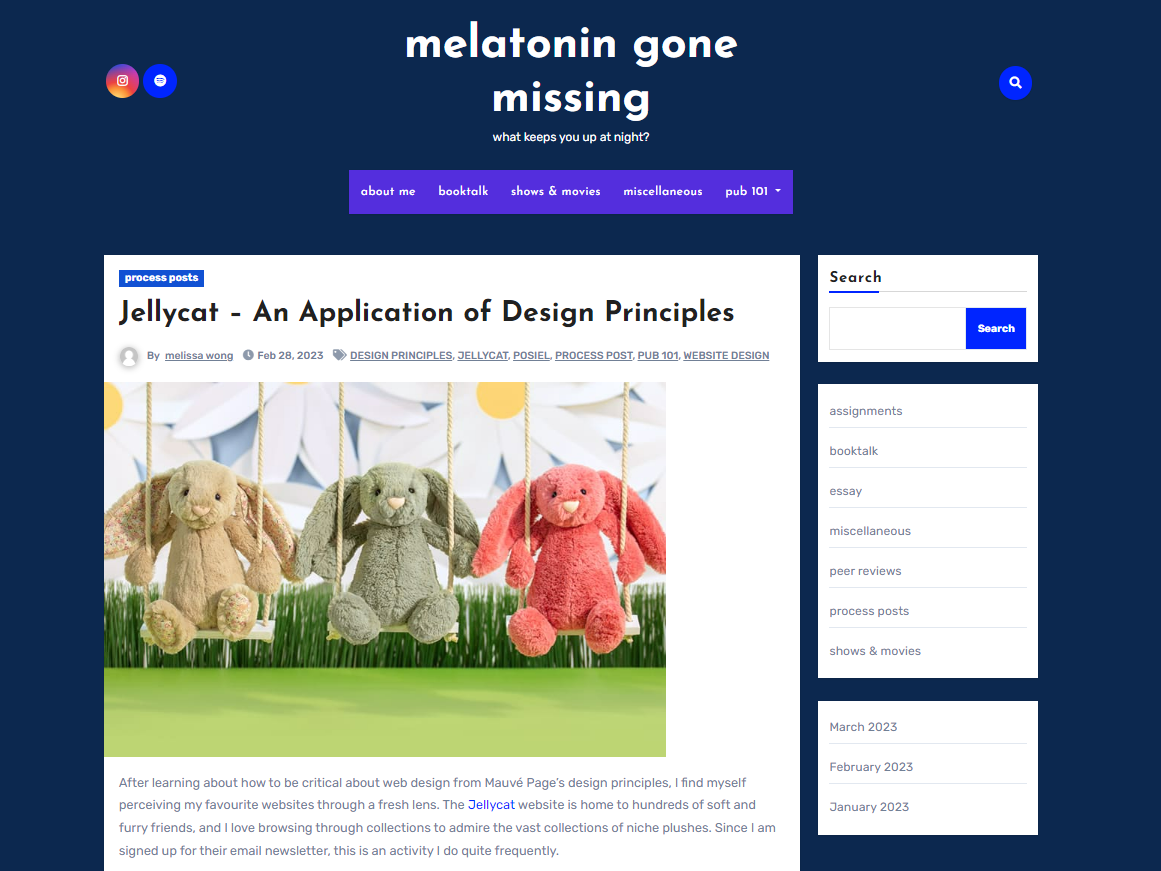An in-depth review of the marketability of melatonin gone missing – a peer’s blog!
click here to visit ‘melatonin gone missing’
Jellylift is back with another peer review! First and foremost, as we do things here, big shout out to the Melatonin Gone Missing admin, Melissa.
Hey Melissa! I don’t know if you recall, but we actually did multiple group projects together in LING 100 last Spring… perhaps you’ve forgotten but I still hold it dear to me… and what a treat it was to see that I get to review your site! So hold onto your socks while I dish out a proper jellylift-style peer review of Melatonin Gone Missing!
first impression
To start, 5 stars on the catchy name for the site. “Melatonin Gone Missing” has such a fun rhythm to it, and it just rolls off your tongue with the help of alliteration and a sort of swing that just makes sense.
Before I dive into the objective of this review, which is evaluating Melatonin Gone Missing’s audience, I need to first address Melissa’s Application of Design Principles process post.

Holy f**king sh*t, Melissa.
I don’t think it is possible to fully understand the way my eyeballs popped out of my skull when I saw that Melissa reviewed the Jellycat website. As someone who never closes the Jellycat tab in her browser, seeing three Bashful Bunnies plastered across the thumbnail for Melissa’s process post felt like love at first sight. I was beyond ecstatic to discover that Melissa is even subscribed to their email newsletter – a true Jellycat Connoisseur. My first thought was “Melissa is definitely my target audience,” especially after browsing her site and seeing how similarly we view our sites – a digital garden for ourselves rather than an outreaching public.
so… who is your audience, anyway?
One of my first reactions to melatonin gone missing was how the site feels like the inside of a teenage girl’s brain. There’s Taylor Swift fangirl posts, book reviews, movie talk, hobby posts – a smorgasbord of Melissa’s mind. Melatonin gone missing feels like a safe space for young women who need to take solace in simple little pleasures. Kind of like the safety of a gossip corner – it’s not particularly profound by any means, but it’s cozy and fun and relatable. Melissa discusses her own opinions of her audience in her Imaginary Audiences process post, which reflects her ideas of her publics and counterpublics (Warner, 2022). Her blog calls on a specific personality type, as people who like Taylor Swift typically fall into the same category as people who enjoy reading romance novels – an idea which she addresses in her post. It’s universally inviting while also appealing to a niche group. You can hang out on Melissa’s blog whether you’re a Swiftie or not! The nature of her content feels very #justgirlythings. Just a fun romanticized life of all things girly pop!
I could imagine her (un)ironically posting something like this:


Despite Melissa’s blog being a reflection of herself and therefore inviting in similar individuals, it’s still pretty clear that a huge part of her work is directed towards the PUB101 audience. Even in her content posts, she uses a very structured and somewhat formal tone, which sort of takes away from the whole ‘this is my own unique cyberspace’ thing. She expresses in her Imaginary Audiences post that she intends for her viewers to appreciate the “casual, conversational tone that carries throughout [her] blog,” yet this “conversational” tone still feels very controlled in a way that she knows it’s being read and evaluated. With that said, this isn’t a critique of that tone, but rather just an observation. It also isn’t universally applicable to her posts, such as her “about me” page which is quite informal
content, design, and marketability
When addressing Melissa’s marketability in terms of content and design, the two play wonderfully together in order to reach her desired audience. It has a “2am thoughts” vibe with the dark blue and soft, rounded text. The energy of Melissa’s content is sort of chaotic and unhinged, which pairs nicely with the very organized and easily manageable web design. You get exactly what you expect on melatonin gone missing – Melissa’s brain digitized! Her blog is beautifully laid out, one of the best I’ve seen across the PUB101 sites, and is not only incredibly organized but also super easy to manage and follow. For an audience such as young Gen Z girls who have little patience, this web design is perfect. You know where to go, and after a few visits to the site, I know it like the back of my hand. Hollingsworth (2018) discusses the importance of having this “clean, effective user experience” as an element of implementing SEO on your website. Melissa achieves this perfectly, without sacrificing quality.
Despite the topics for her posts being all over the place, they are all somehow perfectly intertwined. There is no specific objective for melatonin gone missing other than showing little pieces of Melissa, in which her target audience is able to see reflections of themselves in her content.
a job well done!
Overall, I think that the aesthetically-pleasing layout and relatability of melatonin gone missing are its key selling features. Melissa does an excellent job of reaching her target audience and making her content accessible and open to her desired public. As Hollingsworth (2018) puts it, “customers know what they want,” and so does Melissa, and Melatonin Gone Missing most certainly delivers.
kicking my feet while reading this <3